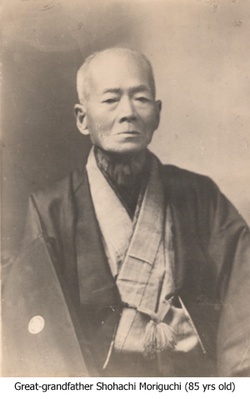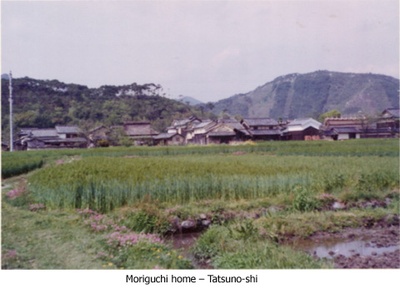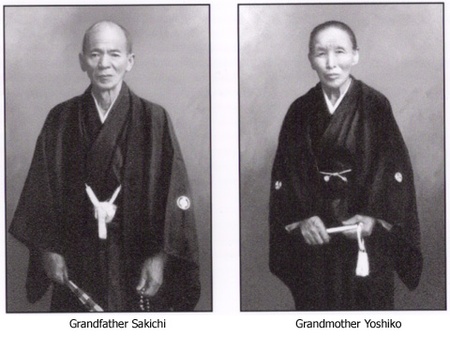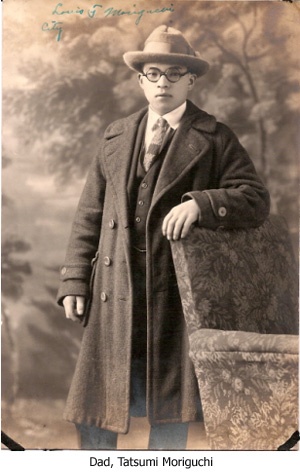In the recent May advertising newsletter received from Marukai, the Japanese supermarket chain in Southern California, there was a full page ad for Ibo No Ito Somen, titled, “Japan’s Best Selling Somen for 120 years.” It further explained what it is, what it is made of, how it is made, and why it is so good. Why it caught my eye is the fact that Ibo No Ito Somen was originated by my great-grandfather, Shohachi Moriguchi (1827-1914), and was instrumental in the emigration of the Moriguchi family to the U.S.
The ad stated that the somen was made in Tatsuno City. Ibo No Ito means the somen (Ito is thread in Japanese. Somen is a thin noodle, like thread.) from Ibo-gun (“county”) of Hyogo-ken (Prefecture). This is near the famous Himeji Castle, one of three classified in Japan as a national treasure.
To explain how Great-grandfather Shohachi began producing somen, I need to first give a short background on him. He was a prosperous large landowner in Ibo-gun. In addition to growing rice and making sake, his home was known as a fude-ya. He sold fude at home and traveled throughout Japan selling the Japanese brush, which was used by artists, calligraphers, or anyone writing or painting. On one of his trips to Nagano Prefecture, he was treated to an extraordinary delicious somen meal. Great-grandfather was able to convince one of the makers of this somen to come to Ibo-gun to teach him how to make this exceptional somen. Making somen would also occupy the winter season, after the rice harvest, to produce extra income.
As the popularity of the Ibo No Ito Somen grew, they formed a cooperative, and by then my grandfather, Sakichi (1868-1944), the younger son of Shohachi, became an influential member of the community and the co-op. Grandfather Sakichi had nine sons. Unlike Great-grandfather, who was able to divide the land holdings between the two sons, Grandfather Sakichi could only have the cho-nan, the eldest, Mitsuji, inherit his land. Therefore, Grandfather Sakichi had to find some way or place for the remaining eight sons to find a place in life. Tamotsu, son number three, was adopted into the Tsuruta family in Kogeta who had no children. Teiji, son number four went to Kyoto and opened a jewelry store. Kinjiro, son number two, and Satoji, son number five prepared to emigrate by learning carpentry and other crafts needed to be self sufficient. There were two opportunities to go abroad, one to Indonesia and another to Brazil. However, since Hyogo Prefecture was not a poor prefecture, it was difficult for citizens to leave.
In 1915, to celebrate the opening of the Panama Canal, San Francisco held the Panama-Pacific Exposition. Because Grandfather Sakichi was an influential member of the community and the Ibo No Ito Somen Co-op, he was able to appoint his second son, Kinjiro, age 23, to display the Ibo No Ito Somen at the Exposition in San Francisco. Uncle Kinjiro boarded the Yokohama Maru in Kobe on July 18, 1915 and arrived in Seattle, Washington, on August 6. Why did he go to Seattle when the Exposition was in San Francisco? He went to settle a dispute with one of the merchants in Seattle who owed the co-op for a large shipment of Ibo No Ito Somen. After settling the dispute, Uncle Kinjiro proceeded to San Francisco to display the somen at the Exposition. While in San Francisco, Uncle Kinjiro surveyed the area for the possibility of emigration for himself and his brothers. He notified Grandfather Sakichi that this might be a good place for the brothers to begin their lives and to make their futures, but for Grandfather to come and verify his findings. Whereupon, Grandfather Sakichi came in June 1916 and satisfied that the future for his sons will be in America, called his sons to come over one by one (a system called yobiyose). My dad, Tatsumi, son number seven, arrived on March 1, 1919, age 14.
Hence, Ibo No Ito Somen has a prominent role in our family, started by our Great-grandfather Shohachi, and was responsible for the future of the Moriguchi family in America.
© 2008 Bob Moriguchi









